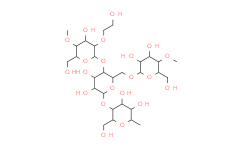| 中文别名 |
羟乙基纤维素;2-羟乙基醚纤维素;纤维素羟乙基醚;2-羟乙基纤维素;羥乙基纖維素;氫氧乙基纖維素;羟乙基纤维素(HEC);3万5万10万涂料用 羟乙基纤维素;羟乙基甲基纤维素;羟乙基纤维素 粘度50000;羟乙基纤维素,LR;羟乙基纤维素[粘度90000];羟乙基纤维素HEC;羟乙基纤维素乙基醚;琼脂糖;食品级羟乙基纤维素;水性涂料用羟乙基纤维素hec;乙基纤维素;中硕羟乙基纤维素;羟乙基-L-纤维素;羟乙基纤维素,1000-1500 mpa;羟乙基纤维素,1500-2500 mpa;羟乙基纤维素,250-450 mpa;羟乙基纤维素,2600-3300 mpa;羟乙基纤维素,3400-5000 mpa;羟乙基纤维素,5000-6400 mpa;羟乙基纤维素,80-125 mpa;羟乙基纤维素 USP级;氢氧乙基纤维素 (200-300mPa·s, 20℃下2%于水溶液中);纤维素羟乙基醚 (200-300mPa·s, 20℃下2%于水溶液中);2-羟乙基纤维素 (200-300mPa·s, 20℃下2%于水溶液中);2-羟乙基醚纤维素 (200-300mPa·s, 20℃下2%于水溶液中);氢氧乙基纤维素 (4,500-6,500mPa·s, 25℃时2%的水溶液);纤维素羟乙基醚 (4,500-6,500mPa·s, 25℃时2%的水溶液);2-羟乙基纤维素 (4,500-6,500mPa·s, 25℃时2%的水溶液);2-羟乙基醚纤维素 (4,500-6,500mPa·s, 25℃时2%的水溶液);纤维素羟乙基醚 (800-1,500mPa·s, 20℃时2%的水溶液);2-羟乙基纤维素 (800-1,500mPa·s, 20℃时2%的水溶液);2-羟乙基醚纤维素 (800-1,500mPa·s, 20℃时2%的水溶液);防冻液用羟乙基纤维素;羟乙纤维素
|
| 英文别名 |
Hetastarch;2-HYDROXYETHYL CELLULOSE;CELLOSIZE WP-40;CELLULOSE, 2-HYDROXYETHYL ETHER;CELLULOSE, HYDROXYETHYL ETHER;HEC;HYDROXYETHYL CELLULOSE;HYDROXYETHYL-CELLULOSE 140'000-160'000;HYDROXYETHYL-CELLULOSE DYED WITH OSTAZIN BRILLIANT RED H-3B;Hydroxyethyl cellulose ether;2-hydroxyethylcelluloseether;ah15;aw15(polysaccharide);aw15[polysaccharide];bl15;cellosize;cellosize4400h16;cellosizeqp;cellosizeqp1500;cellosizeqp3;cellosizeqp30000;HEC、Hydroxyethyl Cellulose;Hespan;Plasmasteril;Pentaspan;Voluven;Onkohas;Hespander;Hespander injection;HAS [German];Penford 290;Penford 280;Penford 260;Ethylex gum 2020;Penford P 208;Essex gum 1360;Essex 1360;Hetastarch [USAN:BAN];Pentastarch [USAN:BAN];O-(2-Hydroxyethyl)starch;Hydroxyathylstarke [German];2-Hydroxyethyl starch ether;Starch 2-hydroxyethyl ether;Tapioca starch hydroxyethyl ether;ASL 607;NOCAS_873934;VZ36173;A starch composed of ;Hydroxyethyl cellulose for antifreeze
|



 扫码关注公众号
扫码关注公众号